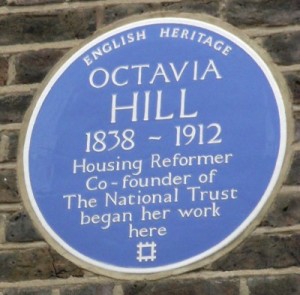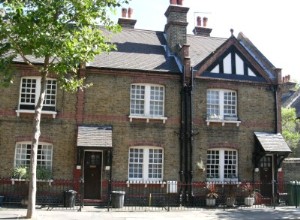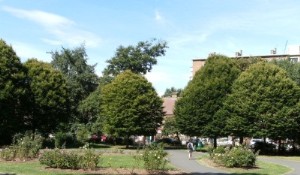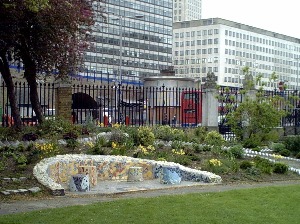LONDON PEOPLE
Octavia Hill - Social Reformer - 1838-1912
london-footprints.co.uk
LONDON PEOPLE Octavia Hill - Social Reformer - 1838-1912 |
|
london-footprints.co.uk |
Octavia Hill was born in Wisbech, Cambridgeshire, the eighth daughter of James Hill, a prosperous corn merchant and former banker and Caroline, the daughter of Dr Thomas Southwood Smith, the pioneer of sanitary reform. James Hill built an infant school, run by Caroline, which was open in the evenings as a community centre for adult education and recreation. But by 1840, James Hill was bankrupt and he later suffered 'a temporary fit of insanity'. The family left Wisbech, and Caroline brought up her children alone in London.
Octavia was particularly concerned with the welfare of the inhabitants of cities, especially London and was a moving force behind the development of social housing. She worked closely with with her sister Miranda (1836–1910), who founded the Kyrle Society. Her campaign for the availability of open spaces for poor people resulted in the establishment of the National Trust in 1895.
This page identifies some of the London locations associated with Octavia Hill which can be seen on my walk routes.
|
In 1841
Caroline and her daughters are enumerated at Pond Street,
Hampstead and in 1851 at Turnpike Road, Finchley. In 1859 Octavia moved with her family to Milton (now Balcombe) Street and taught at the Portman Hall School. I haven't been able to find the exact address. This is a nice example of the terraced houses that make up much of the street however there are some modern replacements. The school referred to was on the corner of present Penfold Street and Church Street. There is no trace of this. St John's Wood walk |
| 1861 CENSUS 14 Nottingham Place Caroline Hill - house proprietor - age 52 Isabella Bain - pupil -
age 13 |
|
1881 CENSUS 14 Nottingham Place Caroline Hill - no occupation - age 72 Scholars: |
 |
FOUR YEARS’ MANAGEMENT OF A LONDON COURT. (first published
Macmillan's Magazine, July 1869) Garbutt Street - Marylebone walk |
|
|
Another early project was St Christopher's Buildings located off Oxford Street. Mayfair walk |
|
HEREFORD BUILDINGS Once
owned by Octavia Hill. Chelsea walk |
|
|
Originally
laid out in the 1880s on the site of a derelict paper
factory by Octavia Hill. Red Cross Garden was described
as 'an open air sitting-room' for the people of
Southwark. It was the scene of the annual Southwark
Flower Show and many fêtes and concerts in its heyday.
Heritage Lottery funding enabled Bankside Open Spaces
Trust to work with local residents, businesses, and
historians to restore the original layout of the
delightful Victorian garden. This included the recreation
of the pond with its rustic bridge, new flower beds,
lawns and benches, and a small information centre and
gardener's office. Southwark walk |
|
| The Army
Cadet Force (ACF) is a British youth organisation that
offers progressive training in a multitude of subjects
from military training to adventurous training (such as
Outward Bound) and first aid, at the same time as
promoting achievement, discipline, and good citizenship
to boys and girls aged 12 to 18. The ACF can trace its beginnings back to 1859, when it was formed in order to prepare youths to enlist in the army in anticipation of an invasion of Britain by the French. It remained in existence after no invasion materialised, thanks in part to the influence of Octavia Hill, because of its positive benefits on youths. She created the Southwark detachment as the first independent unit. This plaque is on the hall in the corner of the Redcross Street Garden. Southwark walk |
|
|
Gable
Cottages in Sudrey Street are similar to the Redcross
Street properties. The cottages were in a style favoured
by Octavia Hill but it wasn't always possible to have so
few dwellings on a piece of land. Southwark walk |
|
|
|
Octavia
Hill was a strong advocate of small scale housing,
cottages and more mixed housing forms. She was also
prepared to experiment. In her 1897 Letter to Fellow
Workers she reported on a new development of
'compound houses' in Charles Street (now14-19 Ranston
Street) ... each of which comes to be practically two distinct cottages one on the top of another. One front door and passage leads to a five-roomed cottage, containing three ground floor rooms and two rooms below with coal cellar, wash-house and small back yard. Another front door leads by a separate staircase to a seven-roomed cottage with three rooms on the first floor and four above. This tenement, too, has separate wash-house, coal cellar and outside staircase which leads down to the yard. It has the advantage of enabling us to get what are practically separate cottages, with little yards, and yet get a somewhat greater height of building than two storeys, so diminishing ground rent without resorting to high blocks. St John's Wood walk |
 |
Octavia
sometimes worked in conjunction with the Church
Commissioners. They redeveloped this 22 acre estate in
Walworth, which had previously been slum housing, in the
early 1900s. The conservation area provides 600
dwellings. Left: Villa Street Right: Portland Street Walworth walk |
|
 |
Octavia
persuaded the Church Commissioners to provide an open
space in conjunction with the above development. This
still exists as Faraday Park (left). Walworth walk She is also associated with the creation
of a public garden from the former churchyard of St
John's Waterloo (right). |
 |
|
Vauxhall
Park was laid out on the grounds of the Lawn (former home
of Henry Fawcett MP) and Carroun House in 1889. The land
had been due for development but through the efforts of
Octavia Hill and others was purchased by Lambeth Vestry.
The Kyrle Society paid the costs of designer Fanny
Wilkinson and the park was opened by the Prince of Wales
in 1890. The gates and railings were designed by C
Harrison Townsend. Only the gate piers survived wartime
salvage but the gate has been replaced. Vauxhall walk |
The 1891 & 1901 census record her as a visitor at Larksfield in Westerham, living on her own means.
Octavia died on 13 August 1912 at her home at 190 Marylebone Road (since redeveloped). She was buried at Crockham Hill after a family funeral but a memorial service was held in Southwark Cathedral.
© london-footprints.co.uk 2009
[Wikipedia Article] [Infed article] [Birthplace Museum] [National Trust] [Homes of the London Poor] [walkslist]